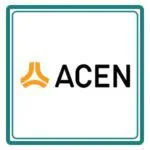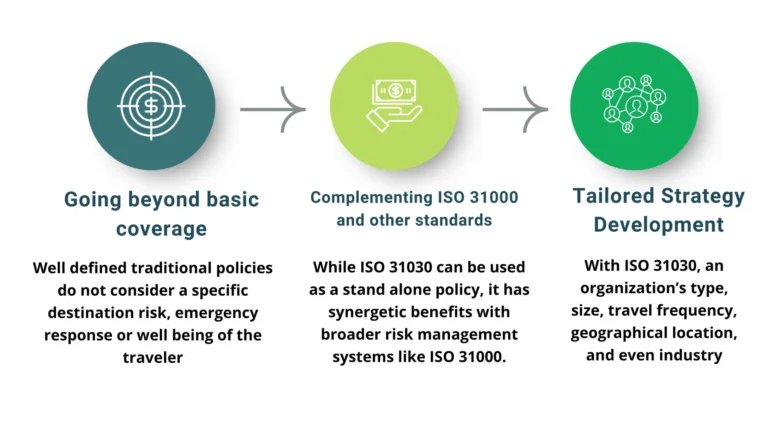ISO 31030 Review: Is It Worth Implementing for Travel Risk Management?

It’s become incredibly normal to integrate corporate travel into the daily activities of several enterprises in this globalized world. Business trips have their advantages and challenges whether one travels for sales meetings, corporate meetings, training, and even for charity trips. Thus, operational, legal, and safety requirements have to be met, which are all intricately structured under the ISO 31030 Travel Risk Management Certification, making corporate travel risk management a necessity.
The International Organization for Standardization (ISO) published ISO 31030 in 2021, and it advocates for a comprehensive strategy for organizations to take while dealing with travel-related risks. This ISO 31030 standard is internationally recognized and provides guidance on how to evaluate, mitigate, and respond to travel risks while ensuring corporate travel compliance and statutory responsibilities to provide safety to employees while traveling for work.
This review will analyze the standard and its components, advantages, and importance in today’s socio-economic landscape. It especially serves HR professionals, compliance officers, travel security risk assessors, as well as those involved with ISO travel compliance policies and the overarching implementation of ISO 31030 certification. Compliance with this standard improves an organization’s effectiveness in safeguarding personnel during business operations and reinforces the organization’s duty of care responsibilities, thereby improving ISO travel risk governance on a holistic level.
What Is ISO 31030?
As a guide to assist companies effectively implement provisions on employee safety during travel, ISO 31030 is best described as the first international standard focusing on systematically managing travel related risks.
ISO 31030 was created due to its increasing use with traveler risks and builds off the base structure of ISO 31000 which is risk management tailored to travel. This applies to businesses of any size, any sector, and region. Public sector bodies, large multinationals, and SMEs all have standardized frameworks with ISO 31030, allowing for customization and scalability.
Key objectives of ISO 31030 include:
- Enhancing traveler safety
- Minimizing disruptions
- Reducing organizational… liability
- Aligning with duty of care obligations
Why Travel Risk Management Matters More Than Ever
Contemporary threats to business travel are severe, multifaceted, and volatile. Without worrying about exhausting the travel risk management system, travelers now manage an array of quarantine measures and unprecedented medical emergencies while navigating age-old travel dangers.
-
Travel Surge After The Pandemic
The world now welcomes people to travel internationally. However, every aspect of travel, including international health issues, is far more unpredictable than what it used to be. -
Geopolitical and Environmental Risks
The possibility of civil disorder, terrorism, and extreme weather are volatile risks. Organizations must build site-specific intelligence, evacuation blueprints, and contingent assets. -
Legal and Moral Duty of Care
Employers must bear legal liability in safeguarding their employees' welfare and safety regardless of travel associated work obligations. Legal neglect may incur lawsuits, regulatory fines, reputational harm, and loss of organizational trust. ISO 31030 integrates these organizational practices for managing travel risks and fulfilling legal and ethical obligations within an auditable structure aligning legal and moral duties.
Types Of Certification
- ISO Certification
- ISO 9001 Certification
- ISO 14001 Certification
- ISO 45001 Certification
- ISO 22000 Certification
- ISO 27001 Certification
- ISO 17025 Certification
- ISO 13485 Certification
- ISO 20000-1 Certification
- ISO 22301 Certification
- ISO 50001 Certification
- ISO 37001 Certification
- IATF 16949 Certification
- ISO 29001 Certification
- ISO 31000 Certification
- ISO 20121 Certification
- ISO 10002 Certification
- ISO 41001 Certification
Get Free Consultation
Our Clients


















Key Components of ISO 31030
ISO 31030 provides a process framework along with documentation workflows which help simplify multi-level management systems. Its strength lies in the process-based approach which ensures all components work together seamlessly. Here are the key components:
- Risk Assessment and Mitigation: Travel risk assessment and mitigation is prescribed for organization heads as mandatory responsibility for all employees during business trips relative to travel destination, duration, traveler’s traveling which is further classified into business, leisure, or work-cation.
- Governance and Policy Development: ISO 31030 encourages the incorporation of travel risk management in the corporate governance framework. This encompasses delineation of functions and responsibilities, creation of escalation processes, and crafting formal communications on travel risks policies within the enterprise that has been devised and is operative at all levels of the organization and is officially disseminated within the business.
- Communication and Training: Information flow is essential before, during, and after traveling. The guide recommends providing advance briefings, real-time notifications, and debriefing sessions after travel. Instruction in cultural etiquette, emergency measures, and cybersecurity also needs to be provided to travelers.
- Monitoring and Continual Improvement: Travel programs alongside incidents and the lessons obtained from them need to be tracked within the organization. Continual improvement is ensured through the relevance of global risks changing is maintained through auditing and feedback systems.
Benefits of Implementing ISO 31030
-
Enhanced Traveler Safety and Well-Being
Active measures of risk mitigation enhances organizational confidence in managing travel risks, which reduces the incidence of travel issues, thereby improving employee confidence, especially for frequent business travelers. -
Legal and reputational risks lessened
ISO 31030 does not only strengthen an organization’s duty of care posture but also helps with legal exposure on incidents which may occur within the organization. Furthermore, showing responsible management of risk is good for the organization’s image. -
Strengthened operational resilience
Disruptions in travel may affect productivity and income. The ISO 31030 allows for a systematic approach to be put in place which ensures business continuity and minimizes losses while facilitating faster recovery. -
Foster trust from stakeholders
Clients, partners and investors appreciate firms that consider safety and social responsibility. Adopting ISO 31030 shows commitment to the best approaches which can improve stakeholder relations and business and competition advantage.
Extra Tips for a Smooth ISO 9001 Journey

Who Should Consider ISO 31030 Implementation?
Regardless of being universally applicable, some organizations require ISO 31030 more urgently than others:
Regardless of being universally applicable, some organizations require ISO 31030 more urgently than others:
- Companies with Global Presence: Use of a single system for dealing with risks during frequent travel to high-risk countries is a necessity.
- Organizations Operating in Volatile Regions: Corporations situated in politically volatile regions or areas prone to disasters stand to gain the most.
- Development NGOs: Involved in high-risk humanitarian missions, NGOs need to safeguard employees while protecting donor engagement.
- Academic and Research Institutions: Educators encounter specific risks given the travel of staff and students for research, study abroad programs, and conferences.
- Governmental Institutions: Complex risks are often faced by employees deployed for diplomatic and developmental activities.
Cost vs. Value: Is ISO 31030 Worth It?
- Financial ROI
Avoiding a singular major incident can lead to savings of over hundreds of thousands in legal, medical and insurance claim expenses. Some insurers may even offer reduced premium rates to established frameworks with proven micromanaged risk management policies and procedures.
2. Operational ROI
The undisrupted productivity and morale of personnel with const staff, minimal disruptions, enhanced response rates and improved staff preparedness are critical. Improved operational business continuity enables confident decision making by the primary decision makers.
3. Strategic ROI
ISO 31030 offers increased brand leverage by positioning the organization as an innovative leader in corporate responsibility. This attracts new partnerships with entities requiring strict compliance protocols while boosting brand value.
Our Verdict
Pros:
- An in-depth and scalable framework
- Improves duty of care
- Legal and operational resilience is higher
- Enhances trust from travelers and stakeholders
Cons:
- Significant resources may be needed during setup and training.
- Not having certifiable status could dissuade some organizations.
Recommendation:
For medium to large organizations, usually traveling internationally, ISO 31030 would be a valuable resource. It is essential for those in volatile or high-risk locations. Smaller businesses can also strengthen their policies by incorporating some of these strategies.
How to Get Started with ISO 31030
-
Conduct a Gap Analysis:
Compare your current travel risk management practices against the ISO 31030 guidelines. Determine which areas are lacking and prioritize them according to the level of risk those areas pose. -
Create or Adjust Policies
Using the gap analysis, draft or modify travel policies to achieve conformity with ISO 31030. These could include new risk assessment, communication, and emergency response plans. -
Bring on Consultants
Bringing in consultants that specialize in ISO could enhance compliance and speed up implementation. Many offer workshops, tailored training sessions, and policy documents designed for ISO 31030. -
Training and Communication
Train stakeholders such as users, HR personnel, and travel coordinators. Ensure understanding and readiness through simulations, e-learning, and briefings. -
Review and Improve
Establish effective feedback loops to monitor your travel risk program. Review incidents, lessons learned, and refine policies periodically.
Conclusion
With the increasing global mobility and prevailing uncertainty, travel risks have become an integral part of strategic business planning; ISO 31030 serves as a guide. It’s not just a mechanical travel policy; it’s a paradigm shift that fosters safety, responsibility, and resilience organizationally.
The required effort and investment in implementing ISO 31030 are dwarfed by the unprecedented value it brings—from enhanced traveler welfare to business continuity and legal safeguarding. The question that now looms for you as a multinational or growing SME is: can you afford not adopting such precision in managing travel risk?
Need assistance with ISO 31030? Reach out for a complimentary consultation.
GET A FREE CONSULTATION NOW
FAQ
What is ISO 31030 and why was it developed?
ISO 31030 is an international standard developed by ISO in 2021 that provides guidelines for managing travel risks. It was created in response to growing global mobility and the need to address safety, legal, and operational concerns linked to business travel.
Is ISO 31030 mandatory for businesses?
No, ISO 31030 is a guideline and not a mandatory or certifiable standard. However, it serves as a best-practice framework that organizations can voluntarily adopt to strengthen travel risk management and fulfill duty of care obligations.
Who should consider implementing ISO 31030?
Organizations with frequent international travel, operations in high-risk regions, or those responsible for staff safety—such as multinational corporations, NGOs, government agencies, and academic institutions—should strongly consider implementation.
How does ISO 31030 differ from a traditional corporate travel policy?
Traditional travel policies often focus on logistics like bookings and expenses. ISO 31030 goes beyond this by addressing risk assessment, emergency planning, communication, and traveler well-being, providing a comprehensive risk management strategy.
Can ISO 31030 be integrated with other ISO standards?
Yes, ISO 31030 complements ISO 31000 (Risk Management) and can be integrated with other management systems like ISO 45001 (Occupational Health & Safety) and ISO 9001 (Quality Management) for a holistic approach.
Why choose PopularCert?
Risk losing customers, contracts, and operational efficiency to certified competitors.
